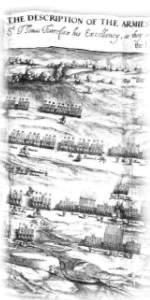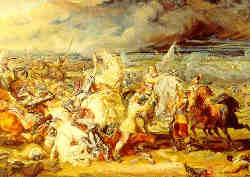|

|
English
Civil Wars
Cromwell had grown to manhood during the reign of James I (King of England 1603-25) and to maturity during that of Charles I (King from 1625). Historians suggest that England was experiencing problems over this period, though they disagree about their nature and seriousness and the degree to which they contributed to the crisis of the 1640s. Some emphasise long-term issues: social tensions resulting from a rapidly expanding population, which caused worsening unemployment, poverty and disorder; class-based tensions caused by the increasing affluence of the middle classes or the declining position of the old aristocracy; constitutional tensions between a crown which was anxious to retain and extend its powers and a parliament which wanted more power for itself and greater rights and liberties for the people; political tensions, caused especially by the failure of royal income to keep up with expenditure and by the attempts of various monarchs to raise extra money;
 and religious tensions, resulting from the desire by an active minority within the state church, the Church of England, to remove some of the ceremonial elements and to create a simpler, 'lower' form of worship. Other historians stress more immediate and shorter-term problems caused by the political errors and in-fighting of the 1620s and 1630s, especially the mistakes and incompetence of Charles I, who stirred up opposition by his tactless handling of parliaments, by ruling throughout the 1630s without calling a parliament, by taking an authoritarian line and exploiting to the full the fiscal and other powers of the crown, and by seeking to impose upon the Church of England a more elaborate and ceremonial form of religion. When in the late 1630s Scotland rose up against the King's religious policies and defeated his English army, Charles was forced to call parliament in 1640 and to make concessions to it, reversing some of his earlier policies. But the political crisis in England continued, for many within parliament pushed for further political, constitutional and religious reforms which Charles, now winning some sympathy and support within the country, would not accept. In 1642, as both King and parliament gathered bodies of armed supporters, the unresolved political crisis deteriorated into an armed confrontation and civil war. and religious tensions, resulting from the desire by an active minority within the state church, the Church of England, to remove some of the ceremonial elements and to create a simpler, 'lower' form of worship. Other historians stress more immediate and shorter-term problems caused by the political errors and in-fighting of the 1620s and 1630s, especially the mistakes and incompetence of Charles I, who stirred up opposition by his tactless handling of parliaments, by ruling throughout the 1630s without calling a parliament, by taking an authoritarian line and exploiting to the full the fiscal and other powers of the crown, and by seeking to impose upon the Church of England a more elaborate and ceremonial form of religion. When in the late 1630s Scotland rose up against the King's religious policies and defeated his English army, Charles was forced to call parliament in 1640 and to make concessions to it, reversing some of his earlier policies. But the political crisis in England continued, for many within parliament pushed for further political, constitutional and religious reforms which Charles, now winning some sympathy and support within the country, would not accept. In 1642, as both King and parliament gathered bodies of armed supporters, the unresolved political crisis deteriorated into an armed confrontation and civil war.
|
